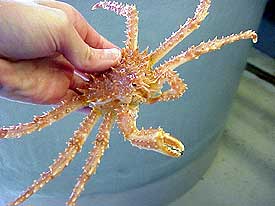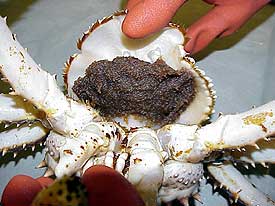 October 16, 2003
"We're figuring out the details of the crabs' life history so that we can understand what might be going on out in the field," Persselin explained. She and Stevens are at the
"If we can gain a finer understanding of the ocean and habitat conditions that crabs need to flourish, we will become better at predicting the oscillations in their populations," Persselin explained. "This will help us to better manage fisheries and control overharvesting." Stevens and Persellin began studying red king crabs at the Kodiak lab in January 2000. Since then they've added research on other commercially important crab species. "We have 111 adult Tanner crabs (Chionoecetes bairdi), 32 adult red king crabs (Paralithodes camtschaticus), 150 juvenile red king crabs, 10 blue king crabs (Paralithodes platypus), and 1 golden king crab (Lithodes aequispinus) in our tanks," said Persselin. In the lab, red king crab start hatching as early as January with Tanner crabs following in late March. "This is the first year we're culturing blue king crab so we're not sure when they'll hatch," she added. The researchers culture crab larvae in five-gallon tanks in the NOAA Fisheries wet lab facility in Kodiak. Adult and juvenile crabs are kept in 650-gallon tanks on a flow-through seawater system. Seawater is pumped from Trident Basin, the region of Chiniak Bay adjacent to the laboratory. "We collect adult female Tanner and red king crabs from Chiniak Bay and bring them into the lab,"explained Persselin. "Most of the female crabs we collect are carrying egg clutches, which hatch into the larvae we culture in the spring." She explained that red king crab females carry eggs for a year. The eggs hatch directly from the female as free-swimming larvae. The larval stage, when the crabs look like tiny shrimp only a few millimeters long, is probably the crab's most vulnerable stage. The larvae eventually molt into tiny crabs. Once they are in the form most people would recognize as a miniature crab, they settle to the ocean bottom. Figuring out why and where they settle will help fishery managers understand what ocean habitats encourage crab population growth and, eventually, which areas of Alaska's ocean bottom should be considered essential habitat for crabs. Stevens has found that red king crab prefer to settle on structurally complex substrate such as algae or plant-like growths called hydroids, rather than on sand. The crabs also have no problem settling on an
Studying crab propagation and growth is not always pretty. When crabs molt, they lose their tough exoskeleton and are vulnerable to all types of predation, including cannibalism, which turns out to be a major problem in the confined research tanks. "We're setting up tanks this winter that will keep each juvenile crab separate," said Persselin. "Cannibalism is obviously not good for the crabs' survival rate." Research is just now beginning on blue king crab life history. Blue king crab stocks around the Pribilof Islands have been declining and the fishery remains closed for the 2003 fishing season. Little is known about blue king crab larvae so, with financial help from the North Pacific Research Board, Persselin and Stevens will be culturing blue king crab larvae and testing their habitat settling preferences. Persselin is also working on culturing Tanner crab larvae, a species whose larvae are much more difficult to raise than king crab larvae. "Tanner and snow crabs are very challenging to raise because of their long larval life cycle," said Persselin. The planktonic larval stage of Tanner crabs lasts at least twice as long as that of red king crab. This is a very vulnerable stage for the larvae: in the wild they experience intense predation. In the lab they are protected from predation--except for some cannibalism--but suffer from damage and disease in their culture tanks. The extended length of their larval period means that they will have a greater chance of becoming diseased or damaged. This winter Persselin is designing and setting up a new culture system that should greatly improve larval survival rate by enhancing the circulation in the tanks. These tanks are called "kreisel" tanks and are often used for culturing lobster larvae and other delicate planktonic larvae. Research fisheries biologist Persselin earned an undergraduate degree at the University of California at Davis, followed by a Masters Degree from the University of Guam in tropical marine biology. Stevens earned his doctoral degree at the University of Washington. To learn more about NOAA Fisheries
in Alaska, visit the NOAA
Fisheries Alaska Region and Alaska
Fisheries Science Center web sites.
Source of News Release & Photographs:
|
|||

